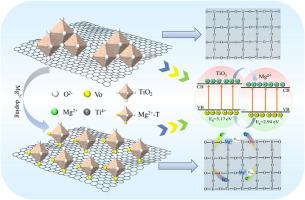Mg2+掺杂对二氧化钛/石墨烯界面的调制:具有导电、耐腐蚀和超疏水特性的二氧化钛涂层
IF 9.4
1区 工程技术
Q1 ENERGY & FUELS
引用次数: 0
摘要
导电涂料在电子器件、储能与转换、新能源汽车底漆等领域显示出巨大的应用潜力,但其耐腐蚀、疏水性、分散性等性能瓶颈限制了其广泛应用。为了解决这些问题,本文创新性地提出了在醋酸体系中通过Mg2+改性的二氧化钛与石墨烯复合导电涂层(Mg-TG)。通过精确调节Mg2+的掺杂量,显著优化了二氧化钛的电子结构和物理性能,并与石墨烯形成了高效的导电网络,成功构建了电阻率低至0.083 Ω cm的高性能复合粉体。先进的表征技术(XPS)和密度泛函理论计算(DFT)表明,缺陷工程的形成激活了晶格氧,导致电子结构调制和材料价键的变化,从而构建了有效的电子传递通道(Ti-O-C, Mg-O-C),确保了涂层中的均匀分布和快速电子循环。此外,通过Tafel曲线试验、水接触角试验(WCA)和涂层实验,证明Mg2+改性有效提高了材料的耐蚀性、疏水性和分散性。这样,涂层不仅有效抵抗介质的腐蚀能力,延长其使用寿命,而且在潮湿环境中保持稳定的电性能,避免因受潮渗透而导致性能下降。同时,Mg2+的改性还促进了材料的均匀分散,提高了涂层的活性和稳定性,为在各种应用场景下的高效性能奠定了坚实的基础。本文章由计算机程序翻译,如有差异,请以英文原文为准。

Modulation of titanium dioxide/graphene interface by Mg2+ doping: Titanium dioxide coatings with conductive, corrosion-resistant and superhydrophobic features
Conductive coatings show great application potential in the fields of electronic devices, energy storage and conversion, and primers for new energy vehicles, but their performance bottlenecks such as corrosion resistance, hydrophobicity, and dispersibility limit their wide applications. In order to solve these problems, this paper innovatively proposes a conductive coating (Mg-TG) composite of titanium dioxide and graphene via Mg2+ modification in the acetic acid system. By precisely modulating the doping amount of Mg2+, the electronic structure and physical properties of titanium dioxide are significantly optimised, and an efficient conductive network is formed with graphene, successfully constructing a high-performance composite powder with a low resistivity as low as 0.083 Ω cm. Advanced characterisation techniques (XPS) and density-functional-theoretic calculations (DFT) indicate that the formation of defective engineering activates lattice oxygens, leading to electronic structure modulation and material valence bonding changes, thus constructing efficient electron transport channels (Ti-O-C, Mg-O-C) and ensuring uniform distribution and fast electron circulation in the coating. In addition, through the Tafel curve test, water contact angle test (WCA) and coating experiments, it was demonstrated that the Mg2+ modification effectively improved the corrosion resistance, hydrophobicity and dispersibility of the material. In this way, the coating not only effectively resists the ability of corrosive media and extends its service life, but also maintains stable electrical properties in humid environments and avoids performance degradation due to moisture penetration. At the same time, the modification of Mg2+ also promotes the uniform dispersion of the material and improves the activity and stability of the coating, laying a solid foundation for efficient performance in a variety of application scenarios.
求助全文
通过发布文献求助,成功后即可免费获取论文全文。
去求助
来源期刊

Energy
工程技术-能源与燃料
CiteScore
15.30
自引率
14.40%
发文量
0
审稿时长
14.2 weeks
期刊介绍:
Energy is a multidisciplinary, international journal that publishes research and analysis in the field of energy engineering. Our aim is to become a leading peer-reviewed platform and a trusted source of information for energy-related topics.
The journal covers a range of areas including mechanical engineering, thermal sciences, and energy analysis. We are particularly interested in research on energy modelling, prediction, integrated energy systems, planning, and management.
Additionally, we welcome papers on energy conservation, efficiency, biomass and bioenergy, renewable energy, electricity supply and demand, energy storage, buildings, and economic and policy issues. These topics should align with our broader multidisciplinary focus.
 求助内容:
求助内容: 应助结果提醒方式:
应助结果提醒方式:


